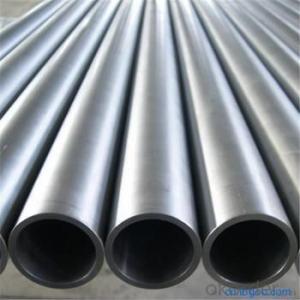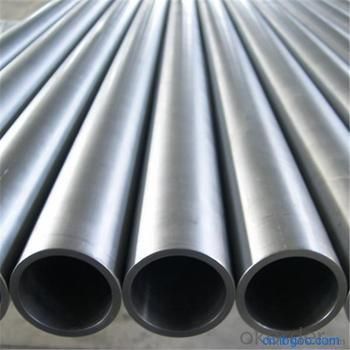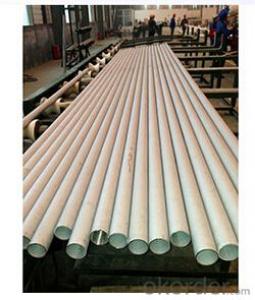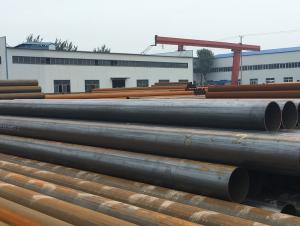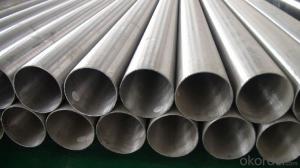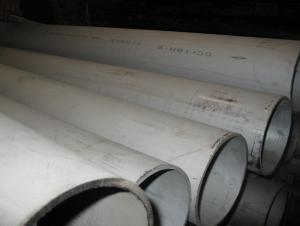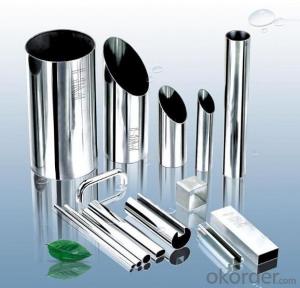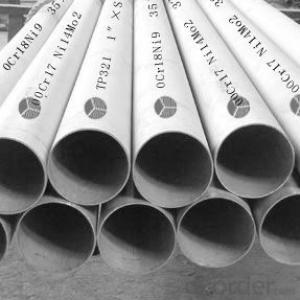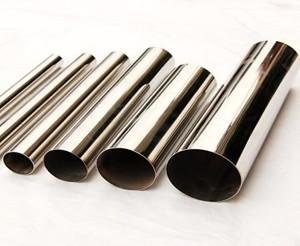Stainless steel pipe S31803
- Loading Port:
- Shanghai
- Payment Terms:
- TT OR LC
- Min Order Qty:
- -
- Supply Capability:
- 200000 kg/month
OKorder Service Pledge
OKorder Financial Service
You Might Also Like
S31803 dual phase stainless steel is composed of 21% chromium, 2.5% molybdenum and nickel nitrogen form 4.5% duplex stainless steel alloy. It has high strength, good toughness and good overall and local stress corrosion resistance. The yield strength of S31803 duplex stainless steel is two times that of austenitic stainless steel, this feature enables designers to reduce weight in the design of products, let this alloy has a price advantage than 316317L. This alloy is particularly applicable to -50 degrees F/+600 degrees F temperature range. Beyond this temperature range of applications, also can consider this kind of alloy, but there are some limitations, especially when used in welding structure.
The characteristics of S31803 duplex stainless steel:
1.S31803 dual phase stainless steel and austenitic stainless steel 316L and 317L compared, S31803 properties of dual phase steel in the resistance to pitting and crevice corrosion is more superior, it has very high corrosion resistance of austenite, and compared, its lower thermal expansion coefficient, high thermal conductivity.
2.S31803 dual phase stainless steel and austenitic stainless steel are compared, the compressive strength is two times, compared with 316L and 317L, the designer can reduce the weight. Alloy 2205 is particularly applicable to - 50 degrees F/+600 degrees F temperature range, in a strictly limited circumstances (especially for welding structure), can also be used to lower the temperature.
Chemical composition: C = 0.030, Mn = 2 Si = 1, P = 0.030 S = 0.020 Cr and 22 ~ 23 Ni and 4.5 ~ 6.5 Mo3.0 ~ 3.5 N0.14 ~ 0.20 (austenite and ferrite)
S31803 dual phase stainless steel applications:
Pressure vessels, pressure tanks, high pressure pipe, heat exchanger (chemical processing industry).
Petroleum natural gas pipeline, the heat exchanger tubes.
And the sewage treatment system.
And the pulp and paper industry classifier, bleaching equipment, storage and processing system.
High strength corrosion environment of the rotary shaft, impeller blades, press roller, etc..
Cargo tank, ship or truck
And food processing equipment
S31803 dual phase stainless steel standard:
ASTM/ASME..A240 UNS S32205/S31803...
EURONORM..1.4462 X2CrNiMoN 22.5.3...
AFNOR....Z3 CrNi 22.05 AZ
DIN....W. Nr 1.4462
S31803 dual phase stainless steel corrosion resistance:
Uniform corrosion
Because the chromium content (22%), Mo (3%) and nitrogen content (0.18%), 2205 of the properties of corrosion resistance is better than that of 316L and 317L in most environments.
Local corrosion
The content of chromium, molybdenum and nitrogen S31803 duplex stainless steel in the oxidizing and acidic solution, has a strong ability to resist corrosion and crevice corrosion.
Stress corrosion resistance
Dual phase microstructure of stainless steel is helpful to improve the resistance of the stainless steel stress corrosion cracking ability. At a certain temperature, oxygen tension exists, and the absence of chloride, austenitic stainless steel will happen to chloride stress corrosion. Because of these conditions is not easy to control, so the use of 304L, 316L and 317L are limited in this respect.
Corrosion fatigue
High strength and corrosion resistance of S31803 duplex stainless steel which has high resistance to corrosion fatigue strength. Processing equipment susceptible to corrosion environment and cyclic loading, the characteristics of S31803 duplex stainless steel is very suitable for such applications.
Structure
Chemical composition of S31803 duplex stainless steel after 1900 degrees /1922 degrees F (1040 degrees /1080 degrees C) solution annealed microstructure can obtain ideal 50 alpha / 50 gamma. If the heat treatment temperatures above 2000 degrees F, may lead to an increase in the ferrite components. Like other dual phase stainless steel, alloy 2205 is easily affected by the intermetallic phase precipitation. Intermetallic phases at 1300 DEG F and 1800 DEG between F at 1600 DEG F precipitation, temperature, the precipitation of the fastest. Therefore, we need to conduct experiments on the S31803 duplex stainless steel, to ensure that no intermetallic phase, testing, reference ASTM A 923.
S31803 dual phase stainless steel processing
Hot forming
We suggest that should be carried out in the following 600 degrees F temperature forming. In hot forming processing, the workpiece should be heated, should be in 1750 degrees F to 2250 degrees F within the temperature range of 2205 alloy under this temperature, very soft. If the temperature is too high, easy to hot tearing 2205 alloy. Below this temperature, the austenite will be broken. Below 1700 degrees F, because of the influence of temperature and deformation, intermetallic will soon form. After hot forming, should be an immediate solution annealed to at least 1900 degrees F temperature, and quenching to restore its phase equilibrium, toughness and corrosion resistance. We do not recommend eliminating stress, but if you must do so, materials to be solution annealed at a minimum of 1900 degrees F temperatures, then rapidly cooling, water quenching.
Cold forming
S31803 dual phase stainless steel can be cut and cold forming. However, due to the high strength and hardness of 2205 alloy itself, it than austenitic steel is more need for cold forming, also because of its high strength, should give full consideration to the factors of springback.
- Q: Can stainless steel pipes be insulated for soundproofing?
- Yes, stainless steel pipes can be insulated for soundproofing. Insulating stainless steel pipes can help reduce the transmission of noise and vibrations through the pipes. There are various methods and materials that can be used to insulate the pipes, such as acoustic wraps, foam insulation, or mass-loaded vinyl. These materials are designed to absorb or block sound waves, preventing them from traveling along the pipes and into the surrounding environment. Properly insulating stainless steel pipes can significantly improve soundproofing in residential, commercial, or industrial settings, making them an effective solution for noise reduction.
- Q: What is the significance of the schedule in stainless steel pipes?
- The schedule in stainless steel pipes refers to the thickness of the pipe walls. It is significant because it determines the pipe's strength, pressure resistance, and suitability for different applications. Different schedules are used for various purposes, such as high-pressure or corrosive environments, ensuring the appropriate performance and durability of the stainless steel pipes.
- Q: Can stainless steel pipes be polished?
- Yes, stainless steel pipes can be polished.
- Q: Can stainless steel pipes be used for cryogenic applications?
- Yes, stainless steel pipes can be used for cryogenic applications. Stainless steel is known for its excellent low-temperature properties, including good strength, ductility, and resistance to corrosion. These properties make stainless steel pipes suitable for transporting and storing cryogenic fluids such as liquid nitrogen, oxygen, or argon. The high strength-to-weight ratio of stainless steel allows for the construction of lightweight and durable cryogenic systems. Additionally, stainless steel pipes can withstand the extreme temperature gradients and thermal stresses commonly encountered in cryogenic applications. However, it is important to choose the appropriate grade of stainless steel that is specifically designed for cryogenic service to ensure optimal performance and safety.
- Q: What is the difference between SCH and XS stainless steel pipes?
- SCH and XS are both schedules used to classify stainless steel pipes based on their wall thickness. However, the main difference lies in the wall thickness itself. SCH stands for Schedule and is a numerical representation indicating the pipe's wall thickness, while XS stands for Extra Strong and represents pipes with a thicker wall compared to SCH pipes.
- Q: How do stainless steel pipes compare to PVC pipes?
- Stainless steel pipes and PVC pipes are both widely used in various industries and applications, but they have distinct differences that make them suitable for different purposes. One of the key differences is the material composition. Stainless steel pipes are made from an alloy of iron, chromium, and other elements, which provides excellent strength and corrosion resistance. On the other hand, PVC pipes are made from a synthetic plastic polymer known as polyvinyl chloride, which offers good chemical resistance but is not as strong as stainless steel. In terms of strength and durability, stainless steel pipes have the upper hand. They can withstand high pressure and are highly resistant to heat, making them ideal for applications that involve transporting hot liquids or gases. PVC pipes, although not as strong, are lightweight and flexible, which makes them easier to handle and install in certain applications. Another important aspect to consider is the cost. PVC pipes are generally more affordable than stainless steel pipes, making them a popular choice for residential plumbing and other low-pressure applications. Stainless steel pipes, being more expensive, are often used in industrial settings where their superior strength and corrosion resistance are necessary. When it comes to lifespan, stainless steel pipes have a longer life expectancy compared to PVC pipes. Stainless steel is highly resistant to corrosion, rust, and other chemical reactions, which allows it to maintain its structural integrity over a longer period of time. PVC pipes, while durable, can degrade over time due to exposure to UV light, extreme temperatures, and certain chemicals. In terms of environmental impact, PVC pipes have raised concerns over the years due to the production and disposal of PVC, which involves the release of toxic chemicals. Stainless steel pipes, on the other hand, are considered more environmentally friendly as they can be recycled and have a longer lifespan. In summary, stainless steel pipes and PVC pipes have their own unique characteristics and advantages. Stainless steel pipes excel in strength, durability, and corrosion resistance, making them suitable for high-pressure and high-temperature applications. PVC pipes, on the other hand, are lightweight, affordable, and easy to install, making them a popular choice for low-pressure applications. Ultimately, the choice between these two materials depends on the specific requirements and constraints of the project at hand.
- Q: Can stainless steel pipes be used for steam applications?
- Yes, stainless steel pipes can be used for steam applications. Stainless steel is known for its high temperature resistance and corrosion resistance, making it suitable for steam systems. It can withstand the high pressure and temperatures that steam applications require without deforming or corroding. Stainless steel pipes are also durable and have a long lifespan, making them a reliable choice for steam applications. Additionally, stainless steel pipes can be easily welded, ensuring a secure and leak-free steam system.
- Q: What are stainless steel pipes used for?
- Stainless steel pipes are commonly used in various industries and applications due to their durability, corrosion resistance, and high strength. They are primarily used for transporting fluids and gases such as water, oil, gas, and chemicals. Additionally, stainless steel pipes find extensive use in plumbing systems, construction projects, automotive applications, food processing plants, pharmaceutical industries, and manufacturing processes where hygiene, reliability, and longevity are crucial.
- Q: What are stainless steel pipes?
- Stainless steel pipes are pipes made from a corrosion-resistant alloy known as stainless steel. This type of steel contains a high percentage of chromium, which forms a protective layer on the surface of the pipe, preventing it from rusting or corroding. Stainless steel pipes are commonly used in various industries such as construction, oil and gas, chemical, and food processing, due to their durability, strength, and resistance to high temperatures and pressures. They are known for their longevity and low maintenance requirements, making them a popular choice for plumbing systems, transportation of fluids, and structural applications. Additionally, stainless steel pipes are highly versatile and can be easily welded, bent, or fabricated to suit specific project requirements.
- Q: Can stainless steel pipes be used for chemical processing applications?
- Stainless steel pipes are a viable option for chemical processing applications. They possess exceptional corrosion resistance, making them suitable for handling a wide range of chemicals and corrosive substances. Their resistance extends to both organic and inorganic chemicals, covering acids, alkalis, and solvents. Moreover, stainless steel pipes exhibit high strength and durability, enabling them to withstand the typically encountered high temperatures and pressures in chemical processing operations. The smooth inner surface of these pipes also prevents the accumulation of deposits, ensuring the efficient flow of chemicals. All in all, stainless steel pipes are a dependable choice for chemical processing applications due to their corrosion resistance, strength, durability, and ease of maintenance.
Send your message to us
Stainless steel pipe S31803
- Loading Port:
- Shanghai
- Payment Terms:
- TT OR LC
- Min Order Qty:
- -
- Supply Capability:
- 200000 kg/month
OKorder Service Pledge
OKorder Financial Service
Similar products
Hot products
Hot Searches
Related keywords
